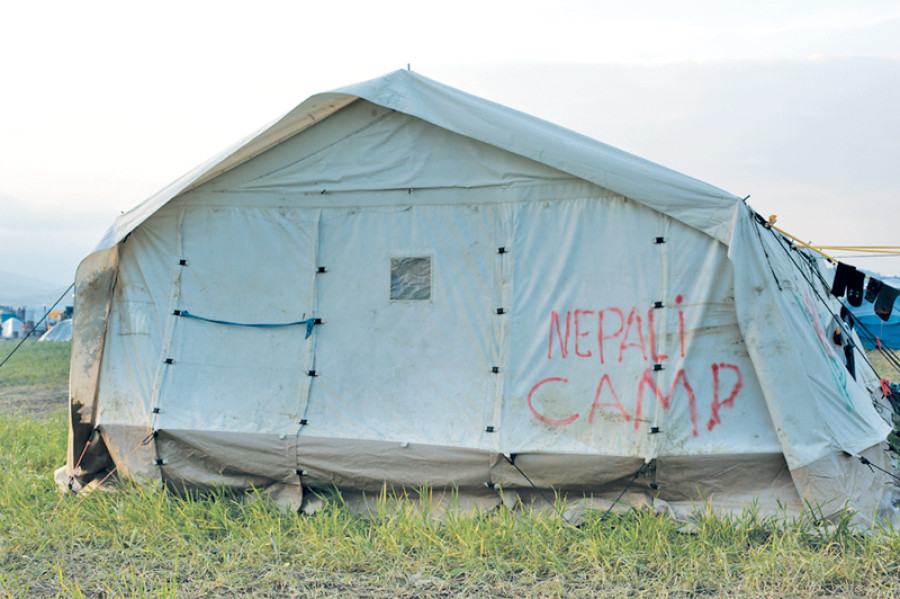Miscellaneous
Echoes of the Nepal Earthquake in Greece
Refugees streamed into Greece from around the world—could it be there were also Nepalis embarking on this quest for a better life?
David Caprara
This month I reported from Idomeni, Greece, where currently over 12,000 refugees are camped out in tents in search of life without war and the hope of prosperity. Each morning in Idomeni begins with the sound of children crying and each day is filled with preparation to protect the low-budget tents that people are staying in against the elements—the situation is a complete humanitarian disaster. One day several weeks ago I was walking through this camp collecting interviews and something caught my eye.
Painted on the side of a Doctors’s Without Borders (MSF) tent were the words “Nepali Camp.” The refugees had streamed into Greece from around the world—could it be that there were also Nepalis embarking on this overland quest to Western Europe for a better life?
I met with a young Syrian woman at the front of the tent to ask who was carrying water to boil for tea if anyone in her tent was from Nepal; she told me that there was not. I asked a coordinator with MSF if she knew of any Nepali refugees in Idomeni, and she postulated that the tent had probably been used in the relief efforts after the April 25 earthquake in 2015.
To see this ghost of the Nepal disaster brought within me a wide mix of emotions.
Frustration was one of the bigger fish in this sea of feelings. Frustration that so many were and continue to be able to take an out-of-sight out-of-mind approach to the disaster, and that there are still hundreds living in shanty towns without proper
shelter. Frustration that although it is widely known that corruption is a problem among high-ranking government officials in Nepal, the overwhelming reasons behind the delays stem from bureaucratic blockages, political squabbling, and a lack of proper planning. Over $4.1 billion USD were pledged by international donors in 2015, and still not a single dollar of this has been able to be
put into action. The National Reconstruction Authority spent the bulk of 2015 deciding who would lead their efforts and what their symbol would look like.
This tent reminded me also of just how much love and support was shown after the quake to help Nepal rise back onto her feet. Though relief poured in from all over the world, what I found most inspirational in the earthquake relief was just how much of this was being done by the Nepali youth. After I received word of the quake, I dropped all of my plans in the United States and altered the course of my life to move to Kathmandu and take part in the relief efforts. What I witnessed were students from every caste and ethnic background from across the spectrum that you can imagine, working side by side as brothers and sisters of the same Nepali family to provide whatever relief they could.
Every week these youth volunteers would cram into small microbuses and drive out to villages in Dhading district and the Nagarkot areas to build temporary shelters out of donated sheets of zinc and assess damage in affected areas. I can imagine that for many this was the first time that many of these youths had ever been blended so thoroughly together as one with such a diverse mix of Nepali society.
Destruction is a bringer of loss and sadness, but it also provides for us a window into the greatest qualities of our species. I would like to believe that one of the lessons learned from the quake is that Nepalis from all backgrounds can work together, and that the country’s greatest strength is in its diversity.
At present the Nepali tent in Idomeni is still blowing in the wind a few hundred meters from the razor-wired fence along the Greece-Macedonia border. The tent’s relocation to a new disaster is a reminder that time is moving forward and that globally the world will have to attend to new crises at hand. We have all learned from the successes and failures of 2015, and whatever holdups there might have been up until the one-year anniversary of the quake, we can put the lessons that we have learned into action and help Nepal rise to heights higher than she has ever scaled before. v
(David tweets at @Caprarad)




 8.12°C Kathmandu
8.12°C Kathmandu










